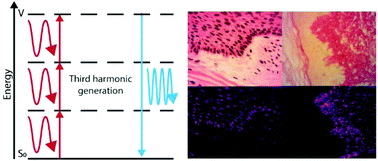Nonlinear microscopy of common histological stains reveals third harmonic generation harmonophores
Abstract
Since its invention over a hundred years ago, histological analysis using coloured dye staining remains the gold standard for histopathology. While these stains provide critical information for a variety of diagnostic purposes, they offer limited two-dimensional histological information. Extending classical histological analysis to three dimensions requires novel imaging approaches such as multiphoton microscopy. Multiphoton microscopy enables multimodal, three-dimensional imaging of histologically stained samples. Specifically, third harmonic generation (THG), a nonlinear optical process in which three incident photons are combined into one by the sample, allows high contrast imaging of tissues stained with absorbing dyes, which in turn act as harmonophores. While this technique has previously been applied to hematoxylin and eosin (H&E) tissue sections, we extend this approach to other commonly used histological stains to demonstrate further potential applications of the technique. We demonstrate THG imaging of both human skin and liver tissue stained with H&E, Verhoeff-Van Gieson (VVG) and Picrosirius Red stains. We find that these stains provide excellent contrast as THG harmonophores, enabling high resolution imaging of histological samples. THG imaging of the Verhoeff stain enables easy detection of elastic fibers while Picrosirius Red acts as an effective harmonophore for imaging collagen fibers of all sizes.



 Please wait while we load your content...
Please wait while we load your content...